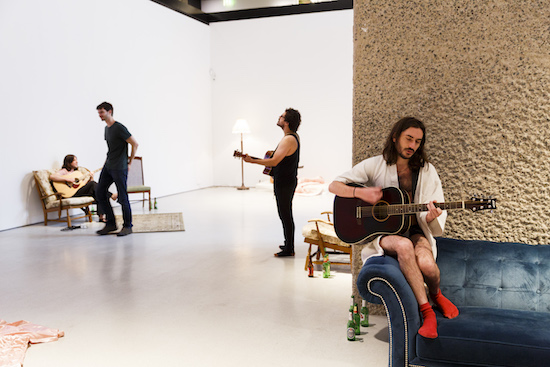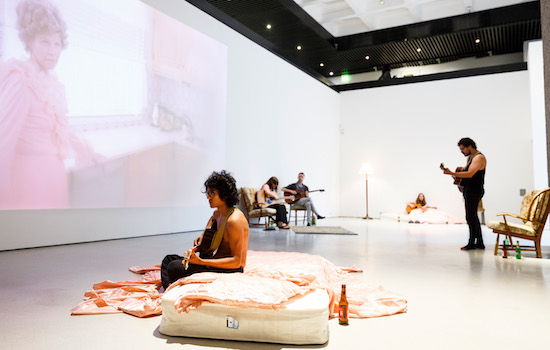Ragnar Kjartansson at the Barbican feels like a hug. Not an unconditional cuddle that doesn’t ask you to engage with the themes being explored, of course… this is not the Wildlife Photographer of the Year. But there is an overwhelming sense of being supported, cupped even, as you glide around the full-to-bursting exhibition of the Icelander’s mainly performance-based pieces. Yes, performance based! A format that my partner termed “squarely” his “least favourite kind of art”. And yet he came out grinning too.
The exhibition encompasses two live works, some films of recorded live work, some works that are full of performance but conceived for film, and then, you know, 144 oil paintings of a dude getting drunk at the Venice biennale (The End, 2009). All these aspects should contrive to create work that could be obtuse, but through a mixture of Ragnar’s affability, the Barbican’s useful physical characteristics, and curator Leila Hasham’s clear love for the subject matter, this is one of those rare exhibitions where you feel like you can just, yunno, hang out.
This sense mainly emanates from the work at the physical centre of the exhibition, 2012’s The Visitors. Nine videos are projected around a room with a pillar in the middle, with said pillar large enough to be a point for projection for two of the videos. A range of musicians (including the wonderful Gyða and Kristín Anna Valtýsdóttir of múm) play an hour-long song, consisting mainly of one repeated lyric: “Once again I fall into my feminine ways.” They are all in different rooms of the same house – a pleasingly dilapidated one in upstate New York – but playing together via headphones.
Their performances are captured with care, both visually and sonically. Ragnar himself is part of the ensemble, taking up the role of aquatic balladeer as he plays an acoustic guitar in the bath. It is beautiful. No one performer over-eggs it, apart from when Kjartansson gets a little splashy, and this frees the audience to pace around or sit as they please, taking in whichever channel most appeals while the harmonies intertwine and the repetition becomes increasingly transcendent. There are mistakes, and moments of humour. Towards the end, the performers migrate into each others’ frames, before opening a champagne bottle and heading out across the fields that stretch away from the house. By this point in the work, all the visitors at the exhibition have crowded around the one screen that shows all the performers, as the surrounding vignettes, still beautifully-staged, now lie empty like vacated Hogwarts portraits. Someone at the exhibition starts singing along with those in the film.
The feeling of joyfulness gained from five, 15 or 150 minutes in that darkened, carpeted room, ensures that you feel caressed for the rest of the exhibition’s duration. A lot of this is to do with the music being very beautiful, but there’s also a sitcom-like sense of being ‘one of the gang’ – a feeling that is perhaps, for a music fan, helped by the presence of many musicians across the works on display. Kjartansson’s narratives are easily malleable to your own, pre-existing fantasies… in your mind’s eye you can see yourself providing back-up vocals for The Visitors as Sigur Rós keyboardist Kjartan Sveinsson gives you a little nod, or taking to horns for The National as they play ‘Sorrow’ for six hours at MoMA (A Lot of Sorrow, 2013). In this sense, my subconscious is clearly well-equipped to appreciate Kjartansson’s whole schtick of gently mocking/elevating the idea of the ‘performer’ as both cultural hero and enigmatic loser.

This is also the main idea on which Take me here by the Dishwasher: Memorial for a Marriage (2014) is gently laid. Ten ‘troubadours’ laze around the gallery’s entrance chamber, drinking beer and singing an endless ode that references an ongoing projection of Kjartansson’s parents acting out a love scene (not as weird as it sounds, promise). The performers pluck their guitars with the affected nonchalance of teen poets, asking the viewer to consider where their own fictions and personal projections begin and end.
Kjartansson may be 40, but his disciplinary and thematic interests are painfully millennial in the way he asks the viewer to sit outside of themselves, revel in artifice and roll around in knowingness. And although the (very good) show copy often alludes to Kjartansson being inspired by performance art from the seventies, it is perhaps this generation, full of enthusiasm for meditative encounters with music and more, that is best equipped to explore the godliness of repetition. And Kjartansson, with his just-magical amount of difference (caucasian and bearded, but from a land of elves), is the perfectly reassuring Shamanic guide.
With thanks to Alastair, Hannah and Ed
Ragnar Kjartansson is at the Barbican until 4 September


